
Frequently
Asked Questions
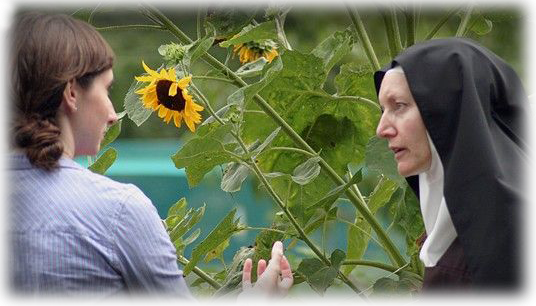
Religious Orders that live the active life serve the Church through an active apostolate and are typically referred to as sisters. This can be in the form of teaching or preaching, ministering to the sick or to the poor, or any other form of work that serves the needs of God’s people. Religious Orders that live the contemplative life serve the Church through lives of prayer and are typically referred to as nuns. They live in monasteries and do not leave the monastery to serve actively. They pray for souls, for the Church, and for the needs of the world. This is their "work." Women in both forms of religious life - the active and the contemplative - are consecrated to God and are committed to the spiritual life and lives of prayer. Dedication of their lives to God is the singular purpose which motivates their work and their every deed.
A typical day in our life:
- 5:30 AM - Rise
- 6:00 AM - Angelus, Office of Readings
- 6:30 AM- Prayer in solitude
- 7:30 AM - Mass
- 8:30 AM - Lauds and Terce
- Breakfast
- 9:30 AM - Work period begins
- 12:30 PM - Mid-Day Prayer, Examination of Conscience
- 12:45 PM - Dinner and cleanup (followed by free time). The sisters organize the afternoon between Mid-Afternoon Prayer, Spiritual Reading and work time.
- 3:15 PM - Work/Novitiate Class/Study
- 4:15 PM - Tea break
- 4:30 PM - Evening Prayer (Vespers)
- 5:00 PM - Prayer in solitude
- 6:00 PM - Supper and cleanup
- 7:00 PM - Community Recreation
- 8:00 PM - Examination of Conscience, Night Prayer (Compline)
- 9:00 PM - Period of solitude beginning of the Great Silence (in speech and action), which continues until the end of Morning Prayer the next day.
- 11:00 PM - Retire
- Into our weekly schedule we have incorporated one unstructured day (hermit day) of solitude where the only community act we assemble for is the Eucharistic Liturgy.
Yes, we leave the monastery for doctor and dental appointments and to attend to business or errands that others cannot take care of for us. In addition, we strive to be a pro-active community with regard to community and spiritual growth and so we attend Carmelite Association meetings - collaborative meetings with other Carmels – Ongoing Formation meetings, and occasional Vocation events.
We do indeed talk, primarily during recreation, which is twice each day, and on recreation days. Throughout the day we strive to keep conversation to a minimum, talking when necessary to accomplish our tasks. Silence is an important element for creating an atmosphere of recollection and prayer- silence in speech as well as in our actions. Our meals are in silence while we listen to a reading from a spiritual book.
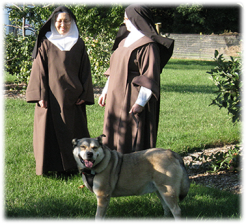
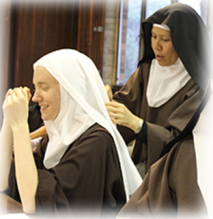
Our work include attending to the daily affairs that keep our monastery operating, such as:
- Answer mail
- Bookkeeping
- Print our own novenas, prayer cards, letter-head stationery, and vocation material
- Write and sell icons
- Design and sell spiritual gift cards, calligraphy notebooks, and photo cards
- Design and keep up our web site
- Serve and attend to our guests when we have priests or others visiting
- Keep up our organic vegetable garden and orchard and to take care of our bee hives
- Perform all of the ordinary kitchen, laundry, and other household duties
- Perform as much of the work as we are able to in order to keep up our monastery, guest houses, and monastery grounds.
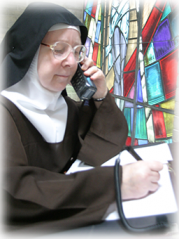
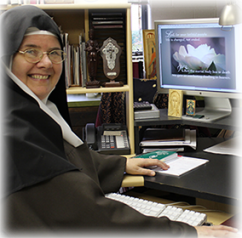
Families are most welcome to visit. We have two guest houses to accommodate them. We do not typically go home to visit family unless a parent is in poor health, in which case we send the sister home to visit and help out when there is a need.
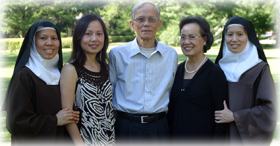

The age-range for joining our community is 21 - 45.
Please see our page on "Vocation Discernment." Also "carefully observe what way your heart draws you, then choose that way with all your strength." (An old Hasidic saying from the Jewish tradition)
Some of our basic requirements are:
- Good health in mind, body, and spirit
- The desire to seek God through a life of prayer and service
- A generous and self-giving spirit
- The desire and ability to live enclosed and with a small group of women in a spirit of joy and peace
- Emotional maturity
You would first:
- Contact our Vocation Director at
- Fill out our "Getting-to-Know-You" form
- Spend time of mutual "getting to know you" with our vocation director through correspondence or phone.
- If it seems as though you may have a vocation to Carmel and you wish to visit, you would then: arrange to visit the community, staying in our guest house.
- After some time is spent in our getting to know one another and you wish to take the next step, you would: visit the monastery for a live-in experience, usually this is for 1-3 months.
- If you then feel that you have a call to Carmel and wish to join our community, you would apply for acceptance.
Formation is six years (Please see our page on Formation Process)
- One year of Postulancy
- Two years of Novitiate
- Three years of Temporary Vows
Our Formation Director will guide and direct you throughout your time in formation. She will be assisted by a formation team to present classes to you during your years of formation in Carmel.